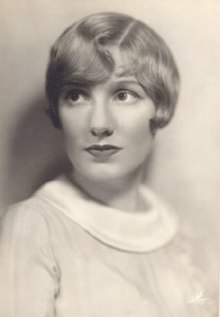Marion Harris
| Marion Harris | |
|---|---|

Harris in 1924
|
|
| Background information | |
| Birth name | Mary Ellen Harrison |
| Born |
April 4, 1896 probably Indiana, United States |
| Died | April 23, 1944 (aged 48) Manhattan, New York City, United States |
| Genres | Jazz, blues, pop |
| Occupation(s) | Singer |
| Years active | 1914-1934 |
| Labels | Victor, Columbia, Brunswick |
Marion Harris (April 4, 1896 – April 23, 1944) was an American popular singer who was most successful in the 1920s. She was the first widely known white singer to sing jazz and blues songs.
She was born Mary Ellen Harrison on April 4, 1896, probably in Indiana.
She first played vaudeville and movie theaters in Chicago around 1914. The dancer Vernon Castle introduced her to the theater community in New York, where she debuted in the Irving Berlin revue Stop! Look! Listen! in 1915.
In 1916, she began recording for Victor Records, singing a variety of songs, such as "Everybody's Crazy 'bout the Doggone Blues, but I'm Happy", "After You've Gone", "A Good Man Is Hard to Find", "When I Hear That Jazz Band Play" and her biggest success, "I Ain't Got Nobody" (originally titled "I Ain't Got Nobody Much").
In 1920, after the Victor label would not allow her to record W.C. Handy's "St. Louis Blues", she joined Columbia Records, where she recorded the song successfully. Sometimes billed as "The Queen of the Blues," she tended to record blues- or jazz-flavored songs throughout her career. Handy wrote of Harris that "she sang blues so well that people hearing her records sometimes thought that the singer was colored." Harris commented, "You usually do best what comes naturally, so I just naturally started singing Southern dialect songs and the modern blues songs."
She was briefly married to the actor Robert Williams. They married in 1921 and divorced the following year. Harris and Williams had one daughter, Mary Ellen, who later became a singer in her own right under the name Marion Harris Jr.
In 1922 she moved to the Brunswick label. She continued to appear in Broadway theatres throughout the 1920s. She regularly played the Palace Theatre, appeared in Florenz Ziegfeld's Midnight Frolic and toured the country with vaudeville shows. After her divorce from a marriage that produced two children, she returned in 1927 to New York theater, made more recordings with Victor and appeared in an eight-minute promotional film, Marion Harris, Songbird of Jazz. After performing in a Hollywood movie, the early musical Devil-May-Care (1929), with Ramón Novarro, she temporarily withdrew from performance because of an undisclosed illness.
...
Wikipedia
